Corporate Accounting Report: Share Buy-backs and Impairment Losses
VerifiedAdded on 2023/04/23
|7
|1472
|327
Report
AI Summary
This report focuses on corporate accounting and reporting, specifically addressing share buy-backs and impairment loss calculations. Part A of the report explains share buy-backs, detailing the process, reasons for buy-backs, shareholder implications, and different types of buy-back methods, including equal access, employee share schemes, and on-market buy-backs. The report also covers the relevant provisions in the Corporations Act 2001. Part B provides an impairment loss calculation for Gali Ltd, including journal entries to illustrate the accounting treatment. The report concludes with a list of references to support the information presented.
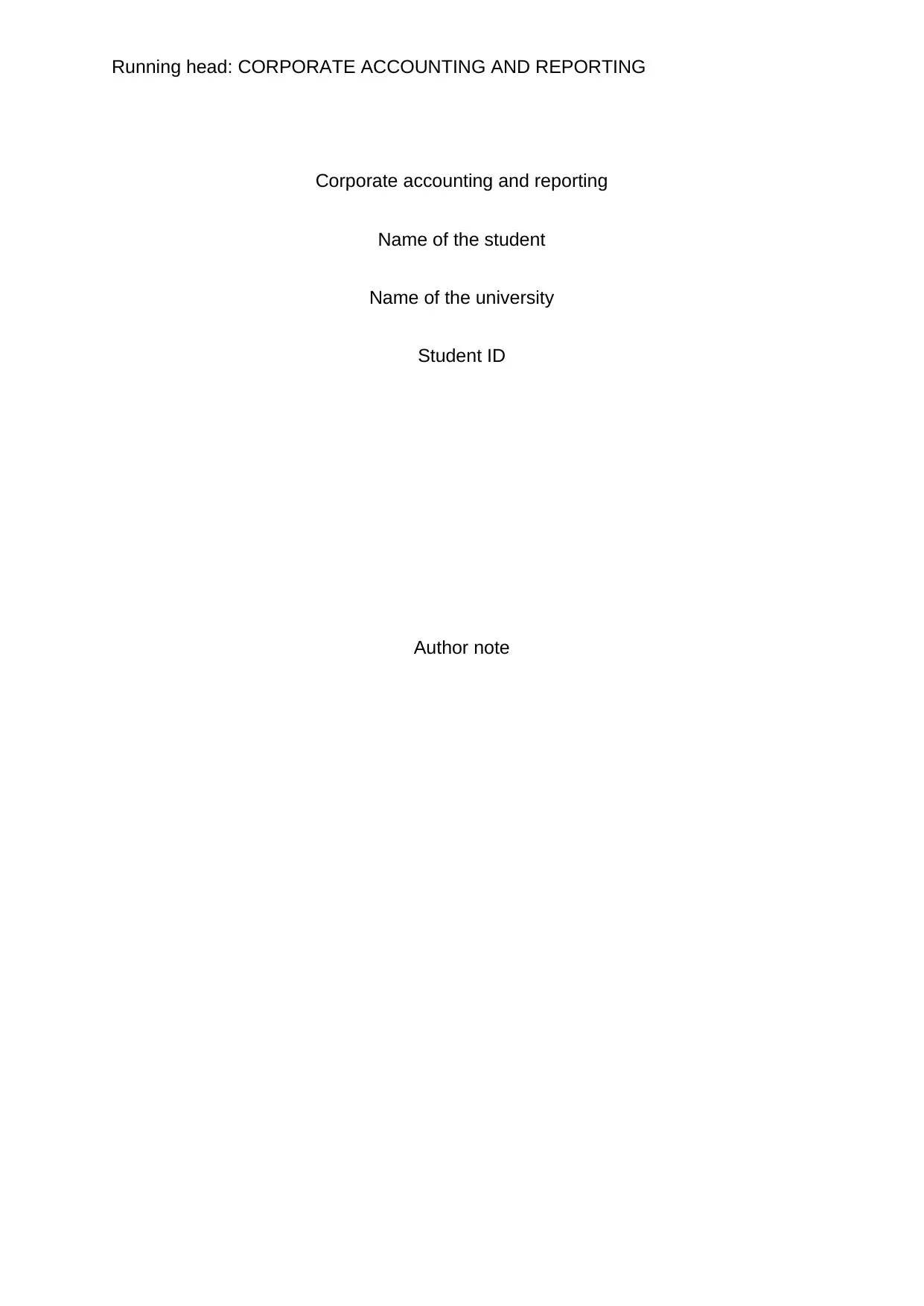
Running head: CORPORATE ACCOUNTING AND REPORTING
Corporate accounting and reporting
Name of the student
Name of the university
Student ID
Author note
Corporate accounting and reporting
Name of the student
Name of the university
Student ID
Author note
Paraphrase This Document
Need a fresh take? Get an instant paraphrase of this document with our AI Paraphraser
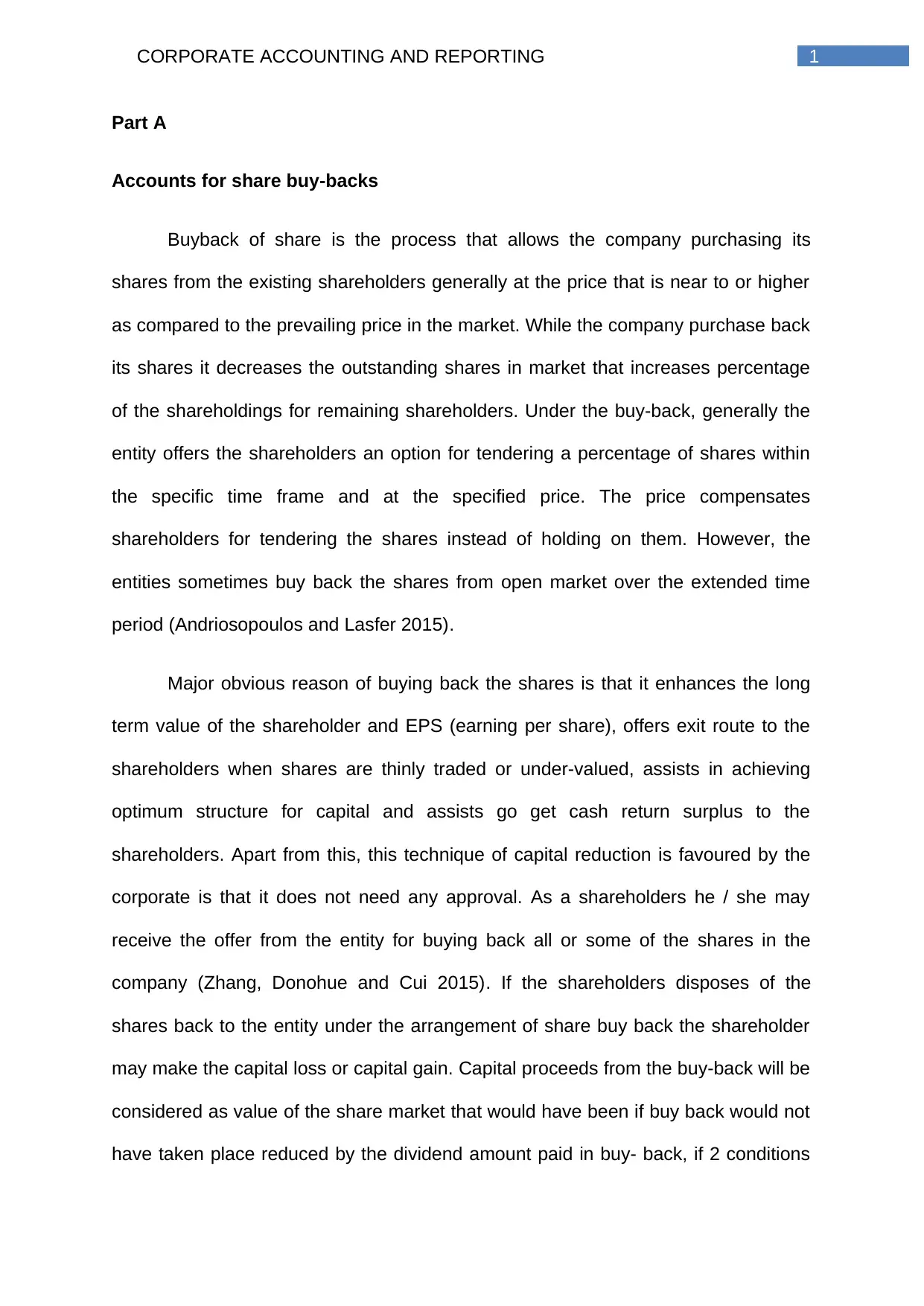
1CORPORATE ACCOUNTING AND REPORTING
Part A
Accounts for share buy-backs
Buyback of share is the process that allows the company purchasing its
shares from the existing shareholders generally at the price that is near to or higher
as compared to the prevailing price in the market. While the company purchase back
its shares it decreases the outstanding shares in market that increases percentage
of the shareholdings for remaining shareholders. Under the buy-back, generally the
entity offers the shareholders an option for tendering a percentage of shares within
the specific time frame and at the specified price. The price compensates
shareholders for tendering the shares instead of holding on them. However, the
entities sometimes buy back the shares from open market over the extended time
period (Andriosopoulos and Lasfer 2015).
Major obvious reason of buying back the shares is that it enhances the long
term value of the shareholder and EPS (earning per share), offers exit route to the
shareholders when shares are thinly traded or under-valued, assists in achieving
optimum structure for capital and assists go get cash return surplus to the
shareholders. Apart from this, this technique of capital reduction is favoured by the
corporate is that it does not need any approval. As a shareholders he / she may
receive the offer from the entity for buying back all or some of the shares in the
company (Zhang, Donohue and Cui 2015). If the shareholders disposes of the
shares back to the entity under the arrangement of share buy back the shareholder
may make the capital loss or capital gain. Capital proceeds from the buy-back will be
considered as value of the share market that would have been if buy back would not
have taken place reduced by the dividend amount paid in buy- back, if 2 conditions
Part A
Accounts for share buy-backs
Buyback of share is the process that allows the company purchasing its
shares from the existing shareholders generally at the price that is near to or higher
as compared to the prevailing price in the market. While the company purchase back
its shares it decreases the outstanding shares in market that increases percentage
of the shareholdings for remaining shareholders. Under the buy-back, generally the
entity offers the shareholders an option for tendering a percentage of shares within
the specific time frame and at the specified price. The price compensates
shareholders for tendering the shares instead of holding on them. However, the
entities sometimes buy back the shares from open market over the extended time
period (Andriosopoulos and Lasfer 2015).
Major obvious reason of buying back the shares is that it enhances the long
term value of the shareholder and EPS (earning per share), offers exit route to the
shareholders when shares are thinly traded or under-valued, assists in achieving
optimum structure for capital and assists go get cash return surplus to the
shareholders. Apart from this, this technique of capital reduction is favoured by the
corporate is that it does not need any approval. As a shareholders he / she may
receive the offer from the entity for buying back all or some of the shares in the
company (Zhang, Donohue and Cui 2015). If the shareholders disposes of the
shares back to the entity under the arrangement of share buy back the shareholder
may make the capital loss or capital gain. Capital proceeds from the buy-back will be
considered as value of the share market that would have been if buy back would not
have taken place reduced by the dividend amount paid in buy- back, if 2 conditions
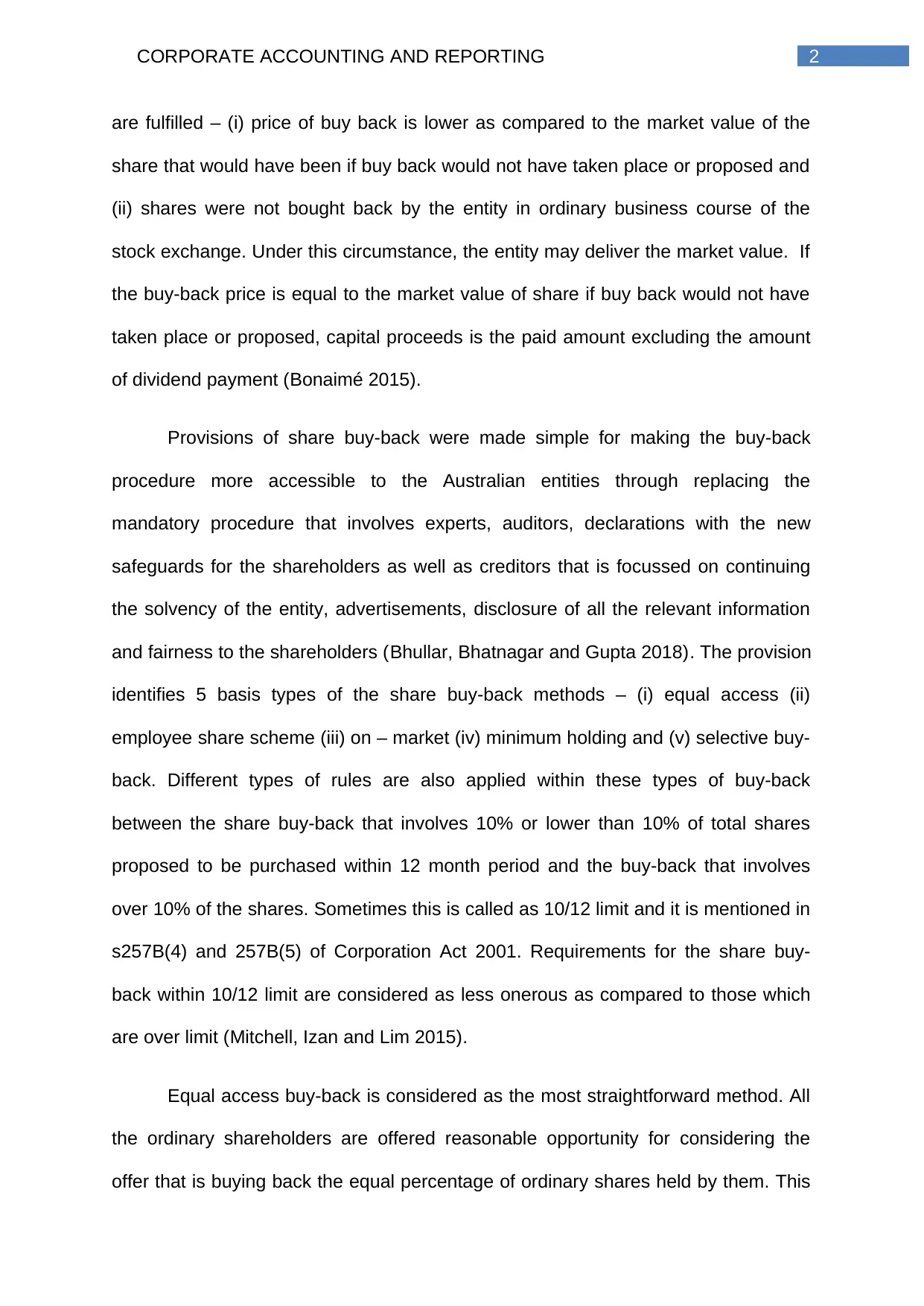
2CORPORATE ACCOUNTING AND REPORTING
are fulfilled – (i) price of buy back is lower as compared to the market value of the
share that would have been if buy back would not have taken place or proposed and
(ii) shares were not bought back by the entity in ordinary business course of the
stock exchange. Under this circumstance, the entity may deliver the market value. If
the buy-back price is equal to the market value of share if buy back would not have
taken place or proposed, capital proceeds is the paid amount excluding the amount
of dividend payment (Bonaimé 2015).
Provisions of share buy-back were made simple for making the buy-back
procedure more accessible to the Australian entities through replacing the
mandatory procedure that involves experts, auditors, declarations with the new
safeguards for the shareholders as well as creditors that is focussed on continuing
the solvency of the entity, advertisements, disclosure of all the relevant information
and fairness to the shareholders (Bhullar, Bhatnagar and Gupta 2018). The provision
identifies 5 basis types of the share buy-back methods – (i) equal access (ii)
employee share scheme (iii) on – market (iv) minimum holding and (v) selective buy-
back. Different types of rules are also applied within these types of buy-back
between the share buy-back that involves 10% or lower than 10% of total shares
proposed to be purchased within 12 month period and the buy-back that involves
over 10% of the shares. Sometimes this is called as 10/12 limit and it is mentioned in
s257B(4) and 257B(5) of Corporation Act 2001. Requirements for the share buy-
back within 10/12 limit are considered as less onerous as compared to those which
are over limit (Mitchell, Izan and Lim 2015).
Equal access buy-back is considered as the most straightforward method. All
the ordinary shareholders are offered reasonable opportunity for considering the
offer that is buying back the equal percentage of ordinary shares held by them. This
are fulfilled – (i) price of buy back is lower as compared to the market value of the
share that would have been if buy back would not have taken place or proposed and
(ii) shares were not bought back by the entity in ordinary business course of the
stock exchange. Under this circumstance, the entity may deliver the market value. If
the buy-back price is equal to the market value of share if buy back would not have
taken place or proposed, capital proceeds is the paid amount excluding the amount
of dividend payment (Bonaimé 2015).
Provisions of share buy-back were made simple for making the buy-back
procedure more accessible to the Australian entities through replacing the
mandatory procedure that involves experts, auditors, declarations with the new
safeguards for the shareholders as well as creditors that is focussed on continuing
the solvency of the entity, advertisements, disclosure of all the relevant information
and fairness to the shareholders (Bhullar, Bhatnagar and Gupta 2018). The provision
identifies 5 basis types of the share buy-back methods – (i) equal access (ii)
employee share scheme (iii) on – market (iv) minimum holding and (v) selective buy-
back. Different types of rules are also applied within these types of buy-back
between the share buy-back that involves 10% or lower than 10% of total shares
proposed to be purchased within 12 month period and the buy-back that involves
over 10% of the shares. Sometimes this is called as 10/12 limit and it is mentioned in
s257B(4) and 257B(5) of Corporation Act 2001. Requirements for the share buy-
back within 10/12 limit are considered as less onerous as compared to those which
are over limit (Mitchell, Izan and Lim 2015).
Equal access buy-back is considered as the most straightforward method. All
the ordinary shareholders are offered reasonable opportunity for considering the
offer that is buying back the equal percentage of ordinary shares held by them. This
⊘ This is a preview!⊘
Do you want full access?
Subscribe today to unlock all pages.

Trusted by 1+ million students worldwide
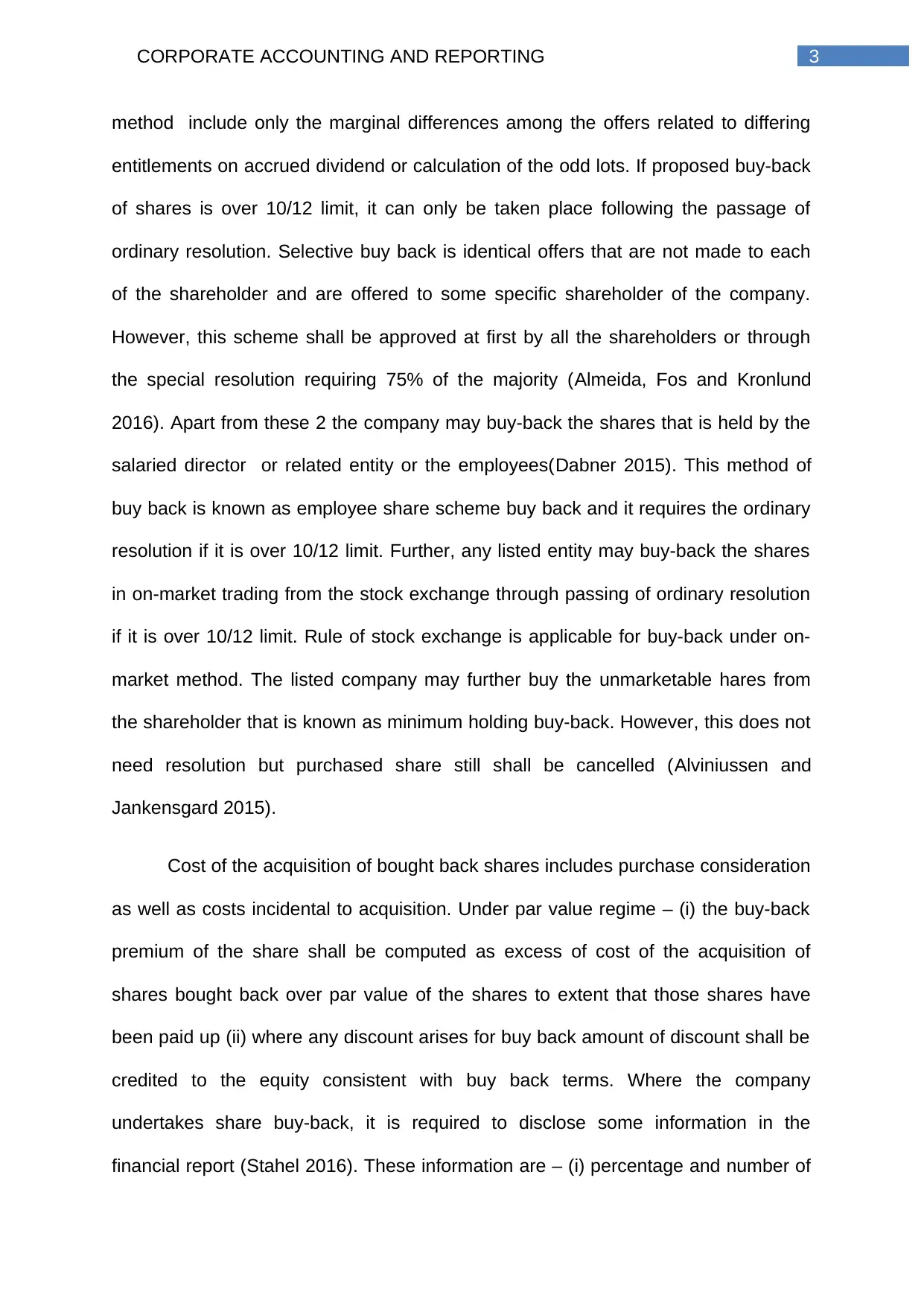
3CORPORATE ACCOUNTING AND REPORTING
method include only the marginal differences among the offers related to differing
entitlements on accrued dividend or calculation of the odd lots. If proposed buy-back
of shares is over 10/12 limit, it can only be taken place following the passage of
ordinary resolution. Selective buy back is identical offers that are not made to each
of the shareholder and are offered to some specific shareholder of the company.
However, this scheme shall be approved at first by all the shareholders or through
the special resolution requiring 75% of the majority (Almeida, Fos and Kronlund
2016). Apart from these 2 the company may buy-back the shares that is held by the
salaried director or related entity or the employees(Dabner 2015). This method of
buy back is known as employee share scheme buy back and it requires the ordinary
resolution if it is over 10/12 limit. Further, any listed entity may buy-back the shares
in on-market trading from the stock exchange through passing of ordinary resolution
if it is over 10/12 limit. Rule of stock exchange is applicable for buy-back under on-
market method. The listed company may further buy the unmarketable hares from
the shareholder that is known as minimum holding buy-back. However, this does not
need resolution but purchased share still shall be cancelled (Alviniussen and
Jankensgard 2015).
Cost of the acquisition of bought back shares includes purchase consideration
as well as costs incidental to acquisition. Under par value regime – (i) the buy-back
premium of the share shall be computed as excess of cost of the acquisition of
shares bought back over par value of the shares to extent that those shares have
been paid up (ii) where any discount arises for buy back amount of discount shall be
credited to the equity consistent with buy back terms. Where the company
undertakes share buy-back, it is required to disclose some information in the
financial report (Stahel 2016). These information are – (i) percentage and number of
method include only the marginal differences among the offers related to differing
entitlements on accrued dividend or calculation of the odd lots. If proposed buy-back
of shares is over 10/12 limit, it can only be taken place following the passage of
ordinary resolution. Selective buy back is identical offers that are not made to each
of the shareholder and are offered to some specific shareholder of the company.
However, this scheme shall be approved at first by all the shareholders or through
the special resolution requiring 75% of the majority (Almeida, Fos and Kronlund
2016). Apart from these 2 the company may buy-back the shares that is held by the
salaried director or related entity or the employees(Dabner 2015). This method of
buy back is known as employee share scheme buy back and it requires the ordinary
resolution if it is over 10/12 limit. Further, any listed entity may buy-back the shares
in on-market trading from the stock exchange through passing of ordinary resolution
if it is over 10/12 limit. Rule of stock exchange is applicable for buy-back under on-
market method. The listed company may further buy the unmarketable hares from
the shareholder that is known as minimum holding buy-back. However, this does not
need resolution but purchased share still shall be cancelled (Alviniussen and
Jankensgard 2015).
Cost of the acquisition of bought back shares includes purchase consideration
as well as costs incidental to acquisition. Under par value regime – (i) the buy-back
premium of the share shall be computed as excess of cost of the acquisition of
shares bought back over par value of the shares to extent that those shares have
been paid up (ii) where any discount arises for buy back amount of discount shall be
credited to the equity consistent with buy back terms. Where the company
undertakes share buy-back, it is required to disclose some information in the
financial report (Stahel 2016). These information are – (i) percentage and number of
Paraphrase This Document
Need a fresh take? Get an instant paraphrase of this document with our AI Paraphraser
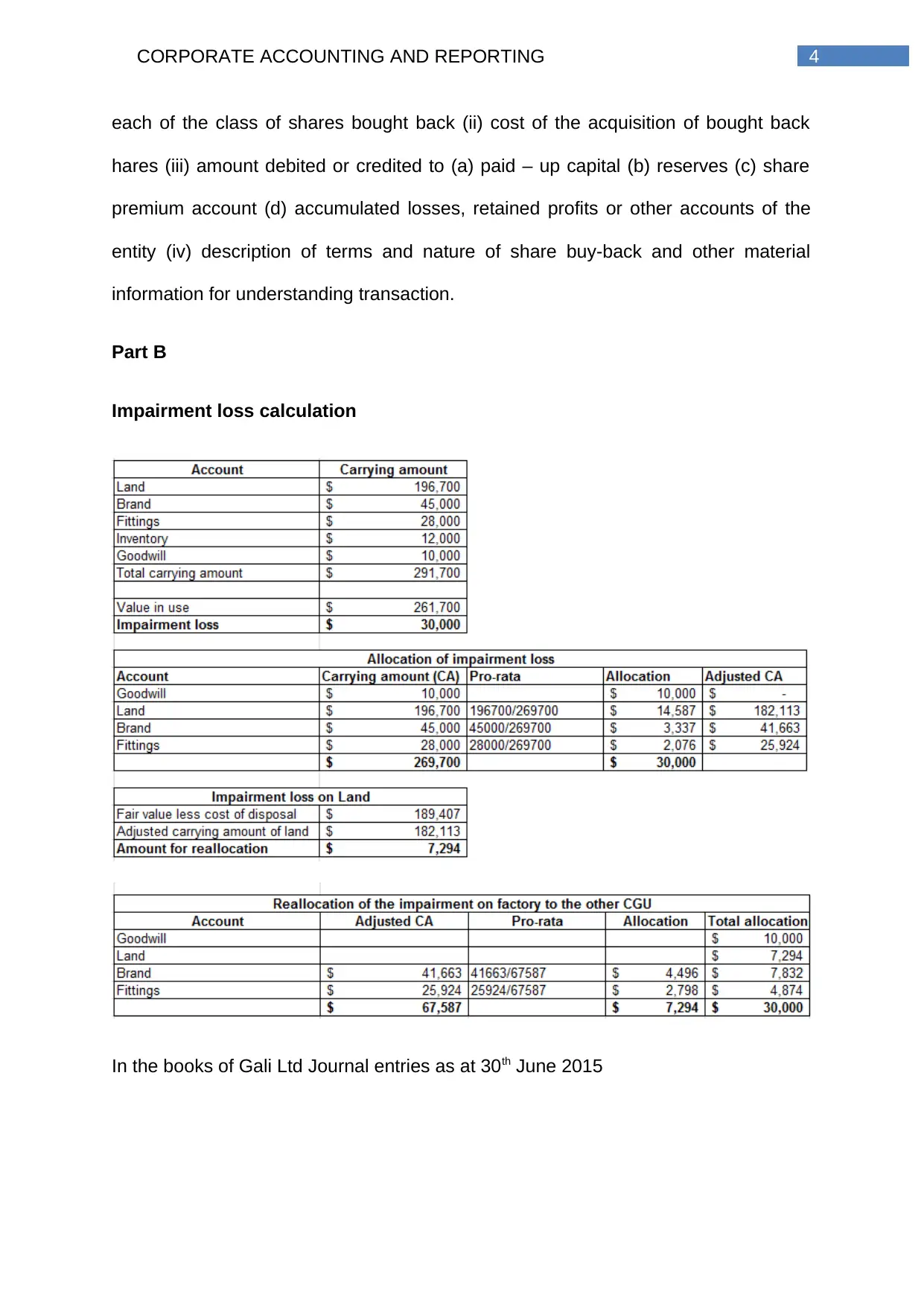
4CORPORATE ACCOUNTING AND REPORTING
each of the class of shares bought back (ii) cost of the acquisition of bought back
hares (iii) amount debited or credited to (a) paid – up capital (b) reserves (c) share
premium account (d) accumulated losses, retained profits or other accounts of the
entity (iv) description of terms and nature of share buy-back and other material
information for understanding transaction.
Part B
Impairment loss calculation
In the books of Gali Ltd Journal entries as at 30th June 2015
each of the class of shares bought back (ii) cost of the acquisition of bought back
hares (iii) amount debited or credited to (a) paid – up capital (b) reserves (c) share
premium account (d) accumulated losses, retained profits or other accounts of the
entity (iv) description of terms and nature of share buy-back and other material
information for understanding transaction.
Part B
Impairment loss calculation
In the books of Gali Ltd Journal entries as at 30th June 2015
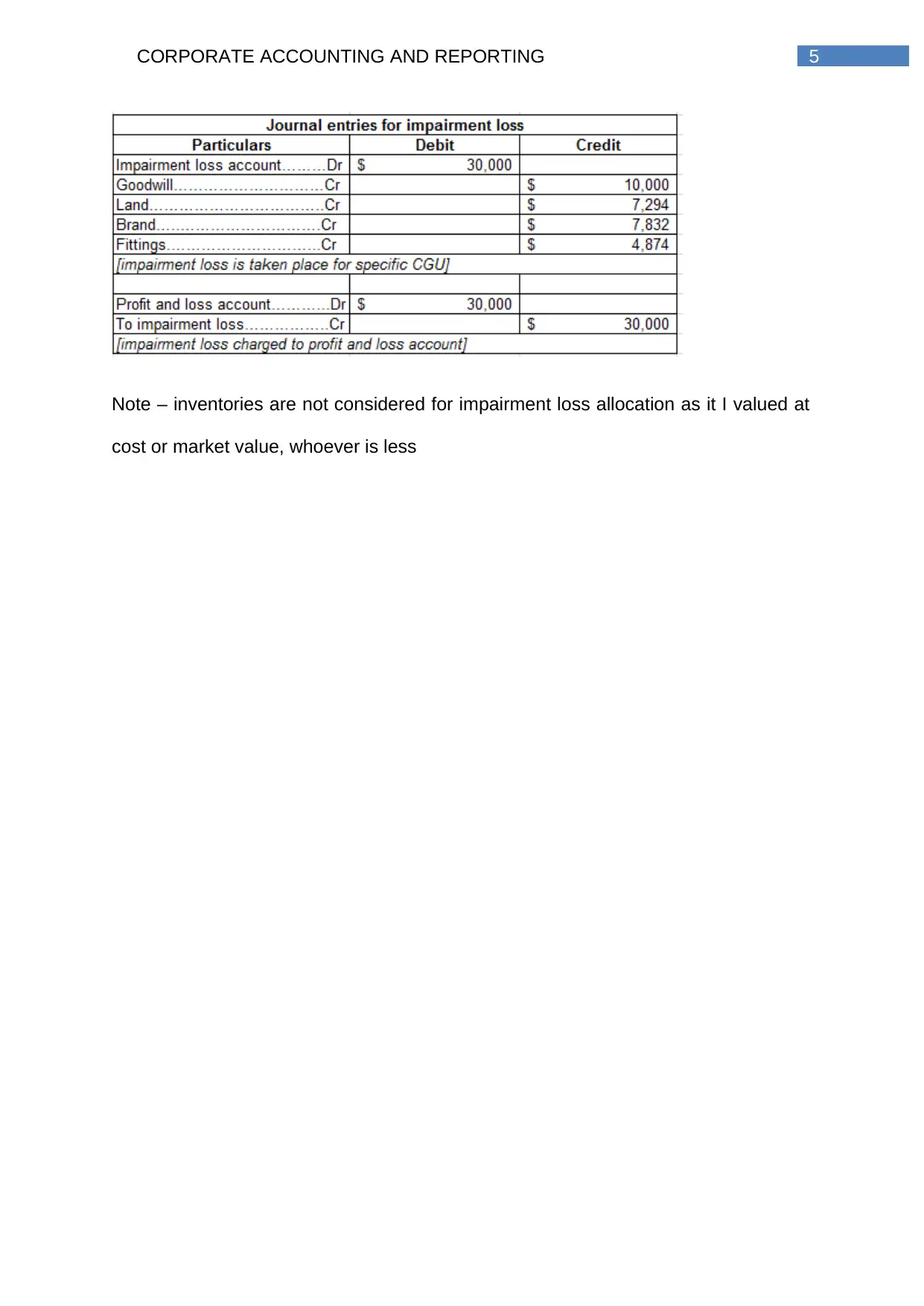
5CORPORATE ACCOUNTING AND REPORTING
Note – inventories are not considered for impairment loss allocation as it I valued at
cost or market value, whoever is less
Note – inventories are not considered for impairment loss allocation as it I valued at
cost or market value, whoever is less
⊘ This is a preview!⊘
Do you want full access?
Subscribe today to unlock all pages.

Trusted by 1+ million students worldwide
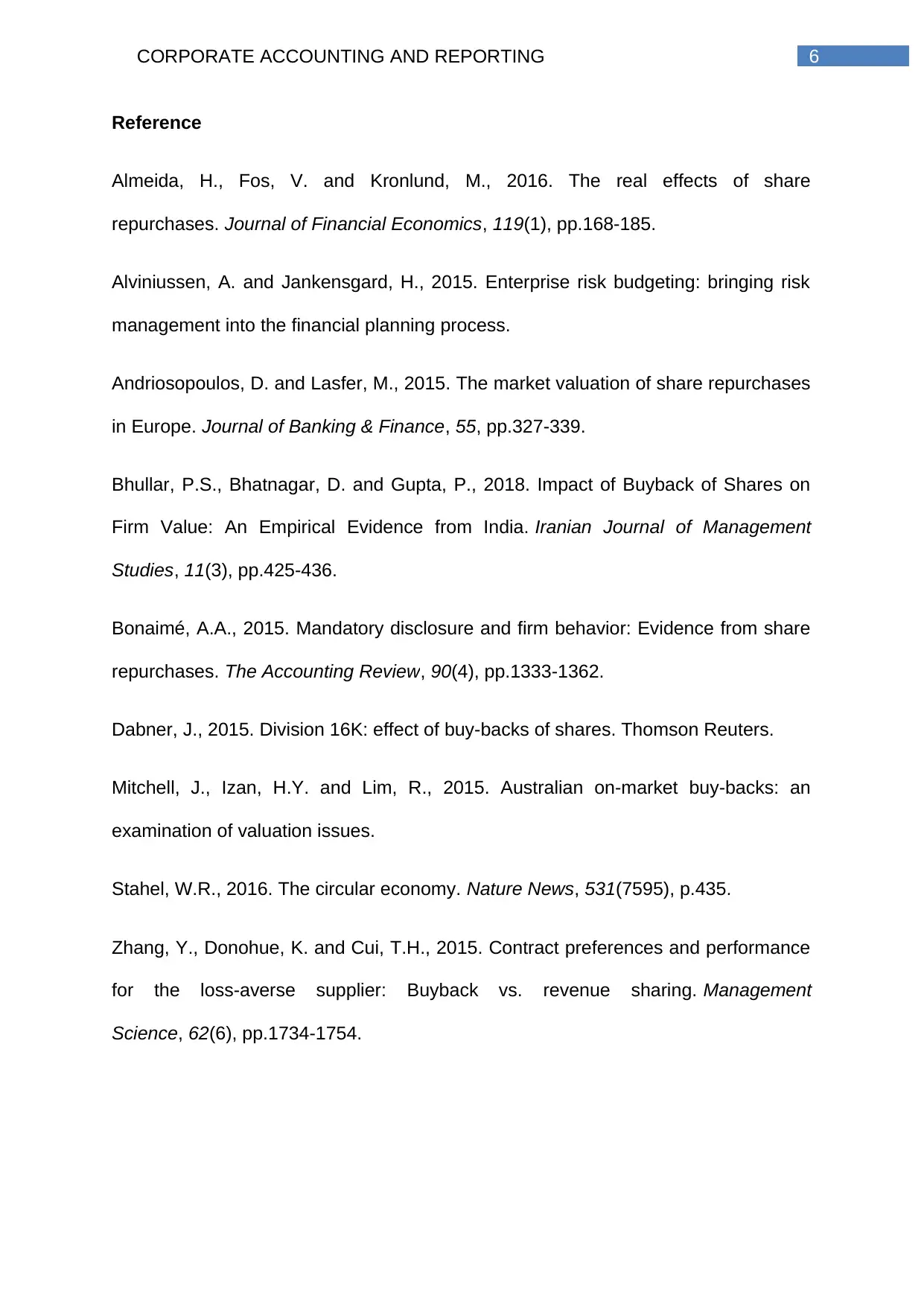
6CORPORATE ACCOUNTING AND REPORTING
Reference
Almeida, H., Fos, V. and Kronlund, M., 2016. The real effects of share
repurchases. Journal of Financial Economics, 119(1), pp.168-185.
Alviniussen, A. and Jankensgard, H., 2015. Enterprise risk budgeting: bringing risk
management into the financial planning process.
Andriosopoulos, D. and Lasfer, M., 2015. The market valuation of share repurchases
in Europe. Journal of Banking & Finance, 55, pp.327-339.
Bhullar, P.S., Bhatnagar, D. and Gupta, P., 2018. Impact of Buyback of Shares on
Firm Value: An Empirical Evidence from India. Iranian Journal of Management
Studies, 11(3), pp.425-436.
Bonaimé, A.A., 2015. Mandatory disclosure and firm behavior: Evidence from share
repurchases. The Accounting Review, 90(4), pp.1333-1362.
Dabner, J., 2015. Division 16K: effect of buy-backs of shares. Thomson Reuters.
Mitchell, J., Izan, H.Y. and Lim, R., 2015. Australian on-market buy-backs: an
examination of valuation issues.
Stahel, W.R., 2016. The circular economy. Nature News, 531(7595), p.435.
Zhang, Y., Donohue, K. and Cui, T.H., 2015. Contract preferences and performance
for the loss-averse supplier: Buyback vs. revenue sharing. Management
Science, 62(6), pp.1734-1754.
Reference
Almeida, H., Fos, V. and Kronlund, M., 2016. The real effects of share
repurchases. Journal of Financial Economics, 119(1), pp.168-185.
Alviniussen, A. and Jankensgard, H., 2015. Enterprise risk budgeting: bringing risk
management into the financial planning process.
Andriosopoulos, D. and Lasfer, M., 2015. The market valuation of share repurchases
in Europe. Journal of Banking & Finance, 55, pp.327-339.
Bhullar, P.S., Bhatnagar, D. and Gupta, P., 2018. Impact of Buyback of Shares on
Firm Value: An Empirical Evidence from India. Iranian Journal of Management
Studies, 11(3), pp.425-436.
Bonaimé, A.A., 2015. Mandatory disclosure and firm behavior: Evidence from share
repurchases. The Accounting Review, 90(4), pp.1333-1362.
Dabner, J., 2015. Division 16K: effect of buy-backs of shares. Thomson Reuters.
Mitchell, J., Izan, H.Y. and Lim, R., 2015. Australian on-market buy-backs: an
examination of valuation issues.
Stahel, W.R., 2016. The circular economy. Nature News, 531(7595), p.435.
Zhang, Y., Donohue, K. and Cui, T.H., 2015. Contract preferences and performance
for the loss-averse supplier: Buyback vs. revenue sharing. Management
Science, 62(6), pp.1734-1754.
1 out of 7
Related Documents
Your All-in-One AI-Powered Toolkit for Academic Success.
+13062052269
info@desklib.com
Available 24*7 on WhatsApp / Email
![[object Object]](/_next/static/media/star-bottom.7253800d.svg)
Unlock your academic potential
Copyright © 2020–2025 A2Z Services. All Rights Reserved. Developed and managed by ZUCOL.




